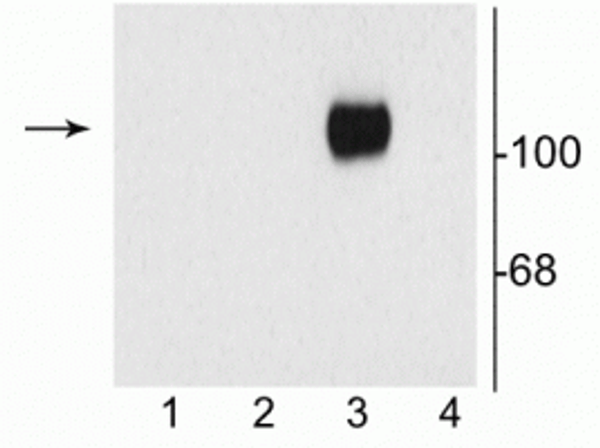| Tissue Specificity | Detected throughout the brain, in brain cortex, cerebellum, thalamus and olfactory bulb. |
| Post Translational Modifications | NMDA is probably regulated by C-terminal phosphorylation of an isoform of NR1 by PKC. Dephosphorylated on Ser-897 probably by protein phosphatase 2A (PPP2CB). Its phosphorylated state is influenced by the formation of the NMDAR-PPP2CB complex and the NMDAR channel activity. |
| Function | Component of N-methyl-D-aspartate (NMDA) receptors (NMDARs) that function as heterotetrameric, ligand-gated cation channels with high calcium permeability and voltage-dependent block by Mg(2+). NMDARs participate in synaptic plasticity for learning and memory formation by contributing to the long-term potentiation (LTP). Channel activation requires binding of the neurotransmitter L-glutamate to the GluN2 subunit, glycine or D-serine binding to the GluN1 subunit, plus membrane depolarization to eliminate channel inhibition by Mg(2+). NMDARs mediate simultaneously the potasium efflux and the influx of calcium and sodium. Each GluN2 or GluN3 subunit confers differential attributes to channel properties, including activation, deactivation and desensitization kinetics, pH sensitivity, Ca2(+) permeability, and binding to allosteric modulators. Forms excitatory glycinergic receptor complexes with GluN3 alone which are activated by glycine binding to the GluN1 and GluN3 subunits. |
| Protein Name | Glutamate Receptor Ionotropic - Nmda 1Glun1Glutamate Nmda Receptor Subunit Zeta-1N-Methyl-D-Aspartate Receptor Subunit Nr1Nmd-R1 |
| Database Links | Reactome: R-RNO-3928662Reactome: -RNO-438066Reactome: -RNO-5673001Reactome: -RNO-8849932Reactome: -RNO-9609736 |
| Cellular Localisation | Cell MembraneMulti-Pass Membrane ProteinPostsynaptic Cell MembraneSynaptic Cell MembranePostsynaptic Density MembraneSynaptic Cell Membrane Targeting Is Dependent Of Grin2b/Glun2b SubunitAssociation With Grin3a Occurs In The Endoplasmic Reticulum |
| Alternative Antibody Names | Anti-Glutamate Receptor Ionotropic - Nmda 1 antibodyAnti-Glun1 antibodyAnti-Glutamate Nmda Receptor Subunit Zeta-1 antibodyAnti-N-Methyl-D-Aspartate Receptor Subunit Nr1 antibodyAnti-Nmd-R1 antibodyAnti-Grin1 antibodyAnti-Nmdar1 antibody |
Information sourced from Uniprot.org







